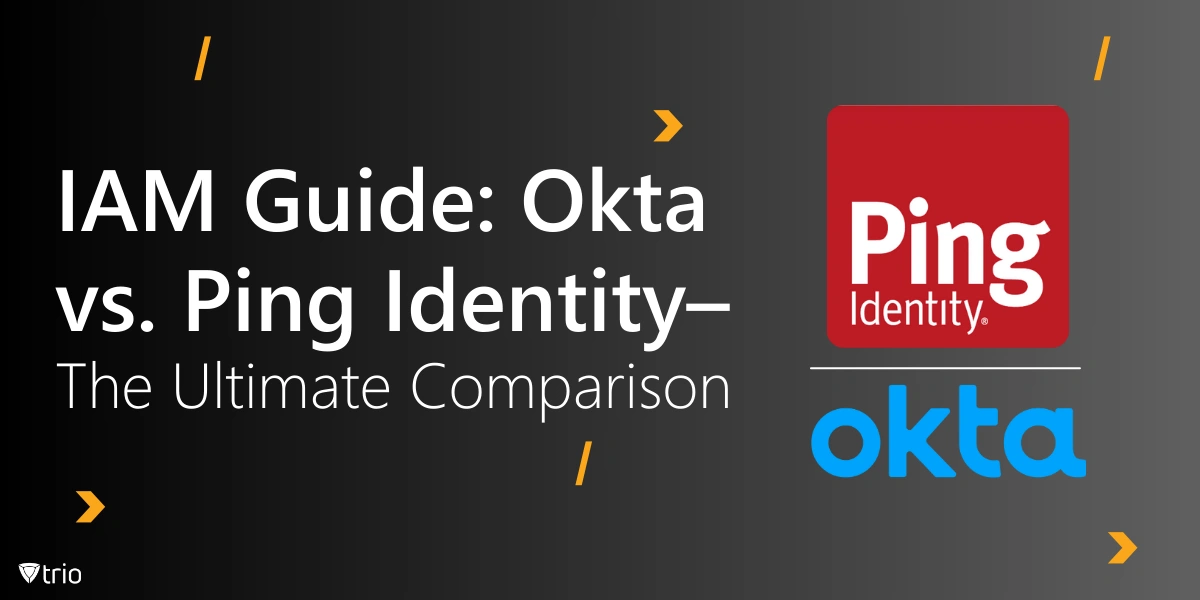In today’s hyperconnected digital landscape, identity and access management (IAM) has become a foundation for organizations seeking to secure sensitive data while providing seamless user access. With threats escalating and user demands increasing, robust IAM solutions are more critical than ever, especially when integrating HRIS systems, managing hybrid work strategies, and ensuring remote work security. The rise of remote work has further complicated access management, making the need for reliable IAM solutions even more urgent. When comparing Okta vs. Ping Identity, both emerge as key players, leveraging their robust Identity Fabric to effectively tackle the evolving challenges of modern security.
Understanding Identity and Access Management (IAM)
Identity and Access Management (IAM) is a critical framework of policies, processes, and technologies designed to manage digital identities and control access to sensitive resources. By verifying users and devices, IAM ensures that only authorized entities can access specific applications, systems, or data. This is especially vital in today’s security landscape, where cyber threats are more sophisticated than ever. Central to modern IAM strategies is the Zero Trust security model, which eliminates implicit trust by continuously validating every access request, regardless of whether it originates inside or outside the network. This approach enhances security, reduces risk, and supports compliance with regulatory standards, making IAM indispensable for businesses navigating hybrid work environments and safeguarding sensitive information.
Overview of Okta and Ping Identity
Choosing the right identity and access management (IAM) solution starts with understanding the unique strengths of each option. Let’s dive into what makes Okta and Ping Identity stand out in this competitive space.
Okta
Okta, established in 2009, has grown into a leading cloud-based IAM provider. Renowned for its seamless single sign-on (SSO) capabilities, Okta empowers businesses to streamline user access while enhancing security.
Core Offerings and Services
Okta provides a comprehensive suite of identity solutions, including:
- SSO: Simplifies access to a wide variety of applications with one secure login.
- Multi-factor authentication (MFA): Offers robust authentication processes to mitigate security risks.
- Lifecycle management: Automates user provisioning and deprovisioning across party applications.
Target Audience
Okta’s flexibility makes it ideal for small-to-medium businesses (SMBs) and large enterprises alike. Its emphasis on scalability ensures it caters to a variety of industries, from tech startups to healthcare.
Ping Identity
Founded in 2002, Ping Identity has a longer history in IAM and has carved a niche as a federated identity management provider. The Ping Identity platform specializes in advanced enterprise-grade solutions.
Core Offerings and Services
Ping Identity’s offerings include:
- Ping authentication: A suite of tools for secure access control.
- Federated SSO: Ensures users’ identities are managed across multiple domains.
- Adaptive MFA: Customizes authentication methods based on risk profiles.
Target Audience
Ping Identity’s robust architecture suits large enterprises seeking customizable and scalable IAM solutions, particularly those in regulated industries like finance.
Feature Comparison
IAM solutions are only as strong as their ability to verify identities and grant secure access. Both Okta and Ping Identity bring unique strengths to the table, making them top contenders in the IAM space.
Authentication and Authorization
Both Okta and Ping Identity excel in authentication processes, but they approach it differently:
- Okta: With its intuitive MFA and easy-to-implement SSO, Okta focuses on delivering a seamless user experience for both SMBs and enterprises.
- Ping Identity: Its Ping authentication suite provides more customizable authentication methods, making it better suited for organizations with complex access control requirements.
User and Device Management
Okta’s emphasis on lifecycle management ensures users’ identities are efficiently handled, from onboarding to offboarding. It also integrates seamlessly with a wide variety of platforms, including mobile devices.
Ping Identity, while equally robust, places more focus on federated identity management, enabling organizations to manage access across cloud-based and on-premises systems.
Customizability and Scalability
Okta’s APIs and developer tools provide significant customization potential, while its scalability caters to businesses of all sizes. Conversely, Ping Identity’s adaptability is unparalleled for large enterprises with unique security risks and compliance needs.
Security and Compliance
Both platforms adhere to a Zero Trust architecture, ensuring secure access and compliance with standards like GDPR and ISO. Okta’s user-friendly approach and Ping’s advanced configurations make them leaders in the IAM market.

User Experience and Support
For businesses adopting identity and access management systems, the user experience can make or break the implementation process. Here’s how Okta and Ping Identity compare in this regard.
Ease of Implementation and Use
Okta stands out for its quick deployment and intuitive interfaces, ensuring minimal disruption to existing workflows. Its clear dashboards enhance the overall user experience.
Ping Identity’s implementation is more complex, often requiring dedicated IT resources. However, its management system offers extensive customization for organizations with advanced needs.
Customer Support and Documentation
Both providers excel in support:
- Okta offers comprehensive documentation and 24/7 customer service.
- Ping Identity provides equally robust support but emphasizes enterprise-level assistance, including tailored guidance for managing user identities.
Pricing and Licensing
Selecting the right IAM solution often boils down to balancing functionality and cost, making it essential to understand each platform’s pricing model.
Pricing Structures
Okta and Ping Identity have tiered pricing models:
- Okta benefits include flexible packages for SMBs and enterprises, often with a free trial.
- Ping Identity’s enterprise-focused pricing aligns with its robust features but may be less cost-effective for smaller organizations.
Cost-Effectiveness
Okta’s straightforward licensing and cost-effectiveness make it ideal for organizations seeking quick Return on Investment (ROI), while Ping Identity’s scalability shines in large-scale implementations.
Real-World Use Cases
Both Okta and Ping Identity are trusted by leading organizations to streamline access management and enhance security across their systems. These platforms provide tailored solutions that meet the specific needs of diverse industries, ensuring secure, seamless user experiences.
Okta in Action
Companies like Slack and JetBlue leverage Okta identity solutions for secure access and improved productivity. Okta’s adaptability has proven beneficial across industries, from tech to retail, especially for those adopting hybrid work strategies.
Ping Identity in Action
Ping Identity powers organizations like Netflix and Chevron, enabling advanced access to applications while maintaining strict compliance. Its enterprise focus ensures high performance in demanding environments, including work-from-home equipment management and securing remote work security.
Which One Should You Choose?
When selecting between Okta and Ping Identity, consider:
- Business Size: SMBs may prefer Okta, while Ping Identity caters to enterprises.
- Industry: Both platforms excel in regulated sectors but differ in approach.
- Budget: Okta is generally more cost-effective for smaller businesses.
- Specific Needs: Complex environments benefit from Ping’s flexibility, while Okta shines in simplicity and scalability.

How Trio Can Complement Your IAM Strategy
Trio, a leading mobile device management (MDM) solution, primarily focuses on managing and securing mobile devices, applications, and data. It also provides some features related to user access control, such as device enrollment, policy enforcement, and security configurations.
Trio enhances IAM platforms like Okta and Ping Identity by:
- Integrating with them to provide additional security for mobile devices within an organization’s IAM framework.
- Strengthening user authentication and access control for mobile devices.
- Streamlining access management across cloud-based applications.
- Offering real-time analytics to proactively address security risks.
- Ensuring a unified and secure approach to managing all endpoints.
With Trio, organizations can amplify the strengths of both Okta and Ping Identity, ensuring a unified approach to managing users’ identities and securing access to applications.
Ready to take your IAM strategy to the next level? Contact us for a free Trio demo today!
Conclusion
Okta and Ping Identity both stand as leaders in the IAM domain, each excelling in distinct areas. While Okta emphasizes simplicity and ease of use, Ping Identity’s enterprise-grade capabilities cater to larger organizations. By understanding your unique needs, you can select the platform that best aligns with your objectives. For enhanced security and management, consider integrating Trio with your IAM solution for a comprehensive approach.
Get Ahead of the Curve
Every organization today needs a solution to automate time-consuming tasks and strengthen security.
Without the right tools, manual processes drain resources and leave gaps in protection. Trio MDM is designed to solve this problem, automating key tasks, boosting security, and ensuring compliance with ease.
Don't let inefficiencies hold you back. Learn how Trio MDM can revolutionize your IT operations or request a free trial today!




